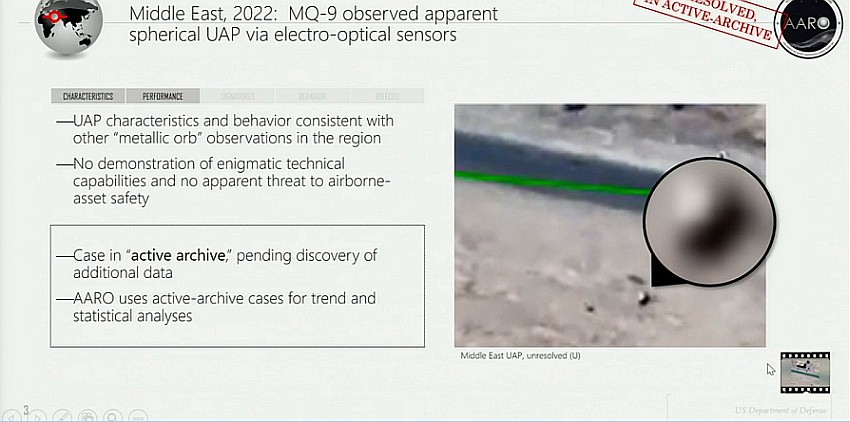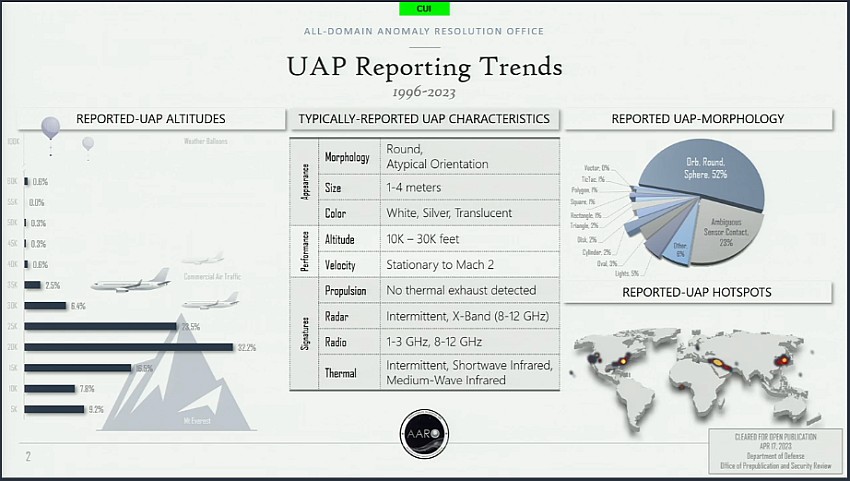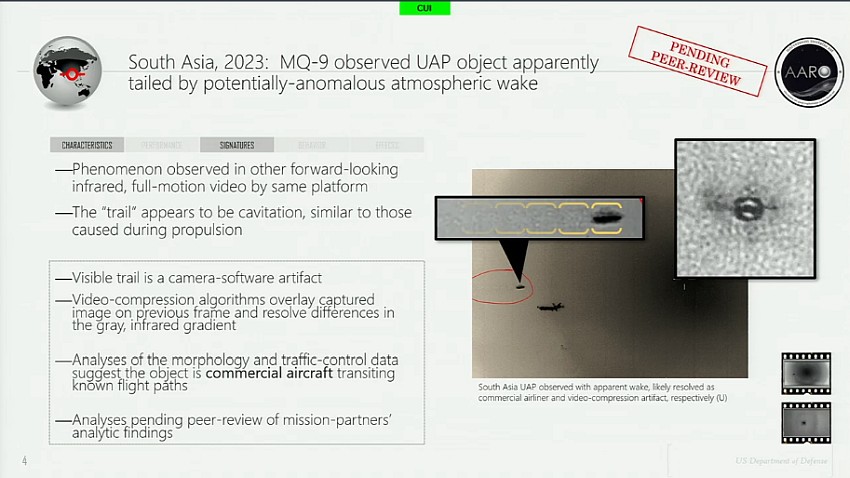Armed Services Committee's Subcommittee on Emerging
Threats and Capabilities, April 19, 2023
Now that the public portion of the April 19, 2023, Senate Armed Services Subcommittee hearings are over, here are a few of my observations.
The Director of the All-domain Anomaly Resolution Office (AARO), Dr. Sean Kirkpatrick, was the only one to give testimony, and while there were some images and videos displayed during the hearings, they were minimal.
As researcher Brad Sparks noted:
"... Of interest was the electro-optical video Dr. Kirkpatrick played of an MQ-9 Reaper drone's imagery of a fast-moving metallic sphere crossing Middle East territory at low altitude in 2022."

During Dr. Kirkpatrick’s opening remarks he outlined the operational basis for AARO’s mission and the methods proposed for their implementation.
“In the nine months since AARO’s establishment, we have taken important steps to improve UAP data collection, standardize the Department’s UAP internal reporting requirements, and implement a framework for rigorous scientific and intelligence analysis, resolving cases in a systematic and prioritized manner.”
One has to wonder why it is that every time there's a new official UAP investigation announced they seem to want to "reinvent the wheel?" There are decades of data available, so why set an arbitrarily recent timeline and criteria for cases to include in their studies?
Dr. Kirkpatrick spoke of a coordinated group of over three dozen experts comprising scientific, military, communications and intelligence resources who will take part in this process, and also stated:
“Meanwhile, consistent with legislative direction, AARO is also carefully reviewing and researching the U. S. Government’s UAP-related historical record.”
The U.S. historian Henry Glassie once observed that “History is not the past, but a map of the past, drawn from a particular point of view, to be useful to the modern traveler.”
Heeding Glassie’s insight into the importance of researching the “UAP-related historical record,” we'd be more than pleased to be fellow passengers along AARO’s retrospective journey into the rediscovery of the past.
Let’s start with the 2004 Nimitz Strike Carrier Group encounter with the so-called “Tic Tac” UFO. Apart from the famous infrared gun-camera footage of the UAP taken by one of the F/A-18 jets from the USS Nimitz, we also learned that the guided missile destroyer USS Princeton’s AN/SPY-1B passive radar system had tracked multiple unknown objects—in groups of five to 10 at times—to as high as 80,000 feet.
Barry Greenwood stated in his book, Clear Intent, that sightings and images from Earth's surface to space would be of particular interest, and that satellite observations of UAPs back to the Condon era were supposedly made of objects entering and departing the atmosphere. What better place to start UAP investigations than “at the top”—literally? Let us examine the decades of data gathered by space-based sensors surveying the globe from their sky-high vantage points to see whether UAPs are indeed extraplanetary visitors, some kind of naturally occurring electromagnetic/atmospheric anomaly, or possibly a group of technologically advanced but very shy local inhabitants?
During Dr. Kirkpatrick’s presentation, Senator Jacky Rosen raised concerns about the role UAPs might have in jeopardizing aviation safety. She pointed out that the US Navy officially acknowledged that between 2004 and 2021 there were 11 near misses involving UAPs and military aircraft that required “pilot action.”

UAP and aircraft interactions are nothing new to serious researchers. Many nations have documented UAP sightings and made them available to the public. The French Space Agency, CNES, did a study of UAP close approaches to aircraft (300 incidents) including near collision course interceptions. The study was compiled by Capt. Dominique Weinstein and both the National Aviation Reporting Center on Anomalous Phenomena (NARCAP) and Project 1947 contributed case files to the project.
Capt. Weinstein also collected hundreds of radar-visual sightings which were part of a subsequent CNES study. Other research by Weinstein yielded 600 credible UAP cases from sources such as pilots in francophone countries, official sources in other countries, and from NARCAP, and Project 1947. Another study Weinstein co-authored with Dr. Richard Haines detailed electromagnetic UAP interference with aircraft. It documented 84 aircraft incidents with new cases continuing to be collected. At least 2000 electromagnetic instances detailing UAP effects on a wide range of electrical equipment have also been documented.

Apart from any other possible aspects to the UAP phenomenon, the potential risk to air safety demands a diligent investigation of the subject and we would recommend that AARO examine this trove of information at their next stop along the highway of historical reacquaintance.
Also mentioned by Dr. Kirkpatrick were “intermittent radio returns” and “intermittent radar returns” associated with some UAPs. Interference in both radar and radio (including on redundant nuclear command radios) have been noted in hundreds of UAP cases dating back to WW II. Perhaps one person’s interference is another’s communication?
Details of UAP cases—both historical and contemporary—have been made available by 45 countries. Canadian cases, for example, from the military, air traffic control, Royal Canadian Mounted Police, and scientific government agencies up to the current date are available at the University of Manitoba. These are unclassified as for years Canada did not consider such incidents to be a national security threat. (See Chris Rutkowski’s Canada UFOs Declassified" and Chris Rutkowski and Geoff Dittman’s The Canadian UFO Report: The Best Cases Revealed.)
For over 70 years dedicated researchers, scientists and scholars have considered UAPs to be a subject worthy of earnest investigation. Many times official government agencies were scornful and on occasion outright hostile towards those who questioned the orthodoxy that UAP were nothing more than balloons, or misidentified aircraft, or people just “seeing things.”
Despite the official disdain, these researchers continued to amass vast catalogs of data from multiple sources, official and otherwise, which we willingly share in the spirit of genuine cooperation and scientific advancement.
Dr. Kirkpatrick and AARO appear to have robust methods in place to be able to review UAP reports and pursue those that will both advance critical scientific study and ensure the security of the nation’s skies. We look forward to the information AARO will be sharing with the public in the future and are gratified that their involvement has finally granted UAP research the imprimatur of legitimacy that it so richly deserved.
— Jan L. Aldrich
